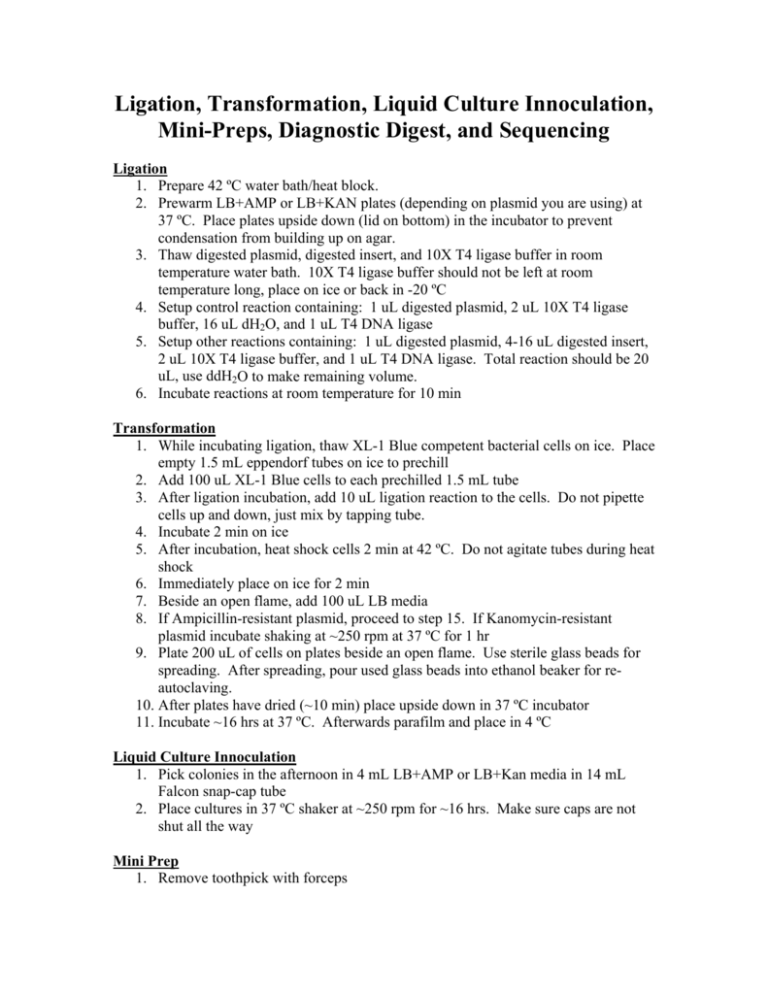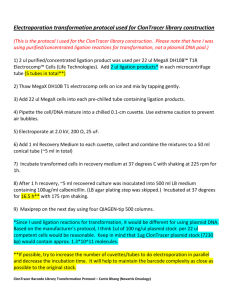Ligation / Transformation / Mini-Prep / Sequencing
advertisement

Ligation, Transformation, Liquid Culture Innoculation, Mini-Preps, Diagnostic Digest, and Sequencing Ligation 1. Prepare 42 ºC water bath/heat block. 2. Prewarm LB+AMP or LB+KAN plates (depending on plasmid you are using) at 37 ºC. Place plates upside down (lid on bottom) in the incubator to prevent condensation from building up on agar. 3. Thaw digested plasmid, digested insert, and 10X T4 ligase buffer in room temperature water bath. 10X T4 ligase buffer should not be left at room temperature long, place on ice or back in -20 ºC 4. Setup control reaction containing: 1 uL digested plasmid, 2 uL 10X T4 ligase buffer, 16 uL dH2O, and 1 uL T4 DNA ligase 5. Setup other reactions containing: 1 uL digested plasmid, 4-16 uL digested insert, 2 uL 10X T4 ligase buffer, and 1 uL T4 DNA ligase. Total reaction should be 20 uL, use ddH2O to make remaining volume. 6. Incubate reactions at room temperature for 10 min Transformation 1. While incubating ligation, thaw XL-1 Blue competent bacterial cells on ice. Place empty 1.5 mL eppendorf tubes on ice to prechill 2. Add 100 uL XL-1 Blue cells to each prechilled 1.5 mL tube 3. After ligation incubation, add 10 uL ligation reaction to the cells. Do not pipette cells up and down, just mix by tapping tube. 4. Incubate 2 min on ice 5. After incubation, heat shock cells 2 min at 42 ºC. Do not agitate tubes during heat shock 6. Immediately place on ice for 2 min 7. Beside an open flame, add 100 uL LB media 8. If Ampicillin-resistant plasmid, proceed to step 15. If Kanomycin-resistant plasmid incubate shaking at ~250 rpm at 37 ºC for 1 hr 9. Plate 200 uL of cells on plates beside an open flame. Use sterile glass beads for spreading. After spreading, pour used glass beads into ethanol beaker for reautoclaving. 10. After plates have dried (~10 min) place upside down in 37 ºC incubator 11. Incubate ~16 hrs at 37 ºC. Afterwards parafilm and place in 4 ºC Liquid Culture Innoculation 1. Pick colonies in the afternoon in 4 mL LB+AMP or LB+Kan media in 14 mL Falcon snap-cap tube 2. Place cultures in 37 ºC shaker at ~250 rpm for ~16 hrs. Make sure caps are not shut all the way Mini Prep 1. Remove toothpick with forceps 2. Spin down for 5 min at 4000 rpm at 4 ºC in big centrifuge 3. Pour off media and place tube upside down on paper towel for a couple of minutes to make sure all liquid is removed 4. Add 250 uL P1 buffer. Vortex. Transfer into 1.5 mL tube 5. Add 250 uL P2 buffer. Mix gently by inverting five times 6. Add 350 uL N3 buffer. Mix gently by immediately inverting five times 7. Spin 10 min at max speed at room temperature 8. Add supernatant to qiaspin column 9. Spin 1 min max speed 10. Wash column with 750 uL PE, spin 1 min max speed 11. Dry column by spinning for 1 min at max speed 12. Add 50 uL dH2O to center of filter in column. Wait 1 min and spin for 1 min max speed 13. Freeze in -20 ºC or do diagnostic digest Diagnostic digest 1. Add 2 uL of plasmid isolated by mini-prep, 1 uL 10X NEB buffer 4, 1 uL NEB BSA, 1 uL FseI, 0.5 uL AscI, and 4.5 uL dH2O 2. Incubate 1-4hrs in 37 ºC water bath/heat block 3. While incubating, pour 0.7-1.5% agarose gel 4. After incubation add 2.5 uL of 5X sample buffer 5. Load 10 uL on 1.5% agarose gel 6. Run at 100 V for ~1 hr 7. Take picture on gel documentation system 8. Select clones that have correct size insert and plasmid Sequencing 1. UV Spec (260 nm) plasmid to determine concentration and purity (OD 260/280 nm should be 1.8-2. 2. Label top with name and sequencing reaction number (i.e. R. Potts #1, R. Potts #2, etc…) 3. Add 6 uL of mini-prep plasmid (200-300 ng/uL) to 1.5 mL tube. 4. Add 6 uL of 1 uM primer (i.e. pCS2-Myc; pCS2-rev; etc..). 5. Fill out online sample submission form. 6. Print out 2 copies of submission form, one for the lab and the other for the sequencing core (L5 or NA2).








